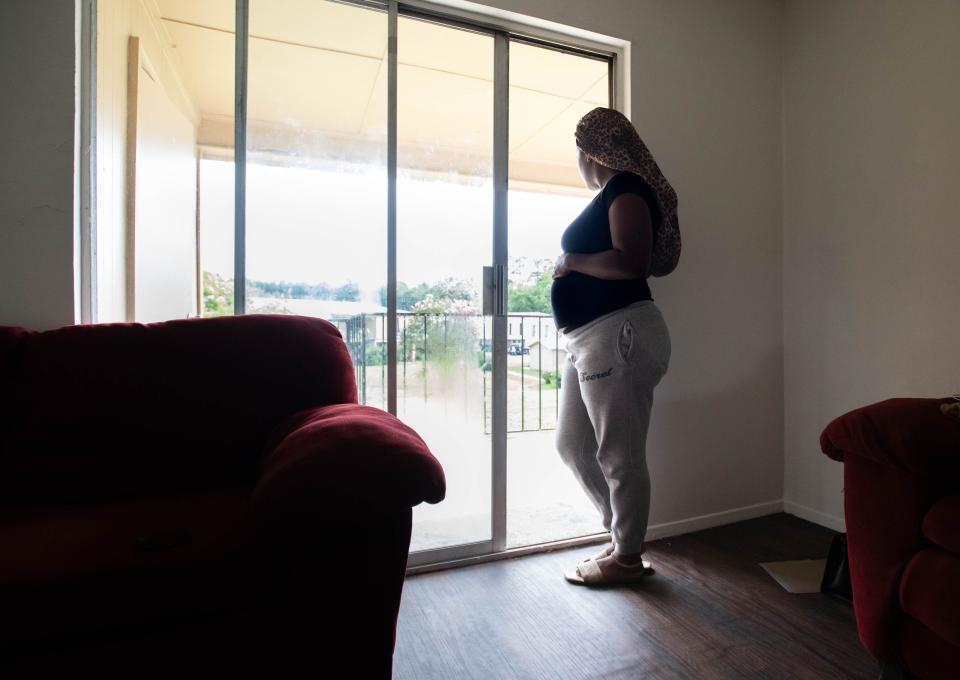This past Easter, Shante Williams found herself in a position she had not experienced before, homelessness.
The mother of three unexpectedly became pregnant, which brought on serious health problems. Unable to work due to her health, she lost all three of her jobs and her home in downtown Pensacola.
Williams stayed with family for a while but knew it wasn’t a long-term solution. When she heard about Re-Entry Alliance Pensacola’s Max-Well Respite Center, a transitional housing program that offers help to people struggling to get back on their feet, she was skeptical at first, but determined to improve her situation for herself and her family.
“I’ve always been self-sufficient. I’ve never really liked being a burden on anybody, so I honestly did not know which way to go,” Williams said. “I really had to swallow my pride and sign up to go there because we were at a point where me and my kids were going to wind up on the side of the road.”
According to this year’s point-in-time count for Escambia and Santa Rosa counties, there is a slight drop in the number of women who reported being homeless in a shelter, but those who are there are staying longer.

Like Williams, many people are having hard time making ends meet due to rising inflation, housing and health care costs. The challenges affect men and women, but single mothers are often hit especially hard because they need a safe, affordable place for their kids, too.
Williams said she was pleasantly surprised to find a community of support at Max-Well Respite Center. Staff and fellow residents not only helped nurse her back to health, but gave her the support she needed, like transportation and childcare, to help her look for work when she recovered.
Now six-months pregnant, she has bounced back from the low she experienced earlier this year and is back working and just moved in with her three children to a new apartment.
“Max-Well Respite Center is Escambia County’s best kept secret,” Williams said. “It’s not for somebody who is just wallowing in their situation. If you’re okay with being on the side of the road, that’s not the place for you. If you have kids, or even if you don’t have kids, if you really want to be self-sufficient again, that place is like, ‘Okay, you’re not a burden on anybody, we can help.’”
Who are the people in the Pensacola area experiencing homelessness?
Data from the annual point-in-time count or PIT count, is used to identify the gaps in services for people experiencing homelessness, as well as support what is working to help them.
This year’s count, conducted during the last week in January, showed 1,123 people were homeless in Escambia and Santa Rosa counties, down from 1,180, last year.
Of those, 365 people were identified as chronically homeless, meaning they were homeless for a year. That number is up from the 234 people identified as chronically homeless in 2023.
This year, 123 veterans were counted as homeless, down from 134, last year. There were 96 unaccompanied youth under the age of 18 counted this year, up from 88 last year.
“Most of our unaccompanied youth are between the ages of 16 and 21,” explained Martika Baker, Opening Doors director of operations. “We do have some youth that are between the ages of 12 and 17 and most of the time it’s because parents fall on hard times due to employment or just losing their housing for whatever reason, and they end up having to be on their own.”
Baker said the PIT count numbers are impacted by a variety of factors. For example, this year they had fewer volunteers to help count. Also in order for a person experiencing homelessness to “count” under federal guidelines they must answer some questions about their situation and not everyone wants to do that.
This year, Baker said the shelters and homeless outreach advocates pushed to get as many people in shelters during the count in order to reach more people. As a result, the number of homeless reported being “sheltered” was 275, up from 183, last year.
Advocates say they know there are many more people from all walks of life experiencing homelessness in various ways, from couch surfing and living in cars to camping on the streets. One of the biggest factors affecting most who are homeless is simply a lack of affordable housing.
Opening Doors and other outreach organizations say there is funding available for people who need housing assistance, but there aren’t enough affordable options that meet basic living standards, even for people who have jobs and have built up their credit, much less for those who haven’t. They also need more support for wrap-around services.
“We do need to meet the need for affordable housing, and we need landlords to be willing to be second chance landlords and to understand that we are trying to help these people get past some things that they’ve done and to get them back on their feet,” said Serene Keick, Opening Doors executive director.
That’s why transitional housing programs, like Max-Well Respite Center, make a difference. Re-entry Alliance Pensacola (REAP) operates the program and earlier this year was short on the money needed to keep it open in the current location.
However, REAP Executive Director Vinnie Whibbs said things are looking up now thanks to an influx of federal, state and charitable dollars that are helping them keep the doors open. Whibbs said the need for affordable housing is huge and the lack of it contributes to the long waiting list they have for people wanting to sign up for the program.
“I think the numbers (of homeless) are increasing,” said Whibbs. “They will continue to increase until you get a really comprehensive plan for affordable housing for Northwest Florida.”
He said it’s especially tough to place women and children because they need their own space, where men can often room together in the same house. REAP’s shelter and transitional housing program for women and children closed last year due to a lack of funding. Max-Well Respite Center and other community programs have helped meet the need, but the need is constant.
Williams is grateful for the help she received, saying it made all the difference.
“I made some really good long-term friends there, people that are coming to my baby shower,” said Williams, “so it’s a real village.”
You can find more information on the Pensacola area’s PIT count numbers on Opening Doors website.
This article originally appeared on Pensacola News Journal: Escambia, Santa Rosa counties show slight drop in homeless numbers
Source Agencies


